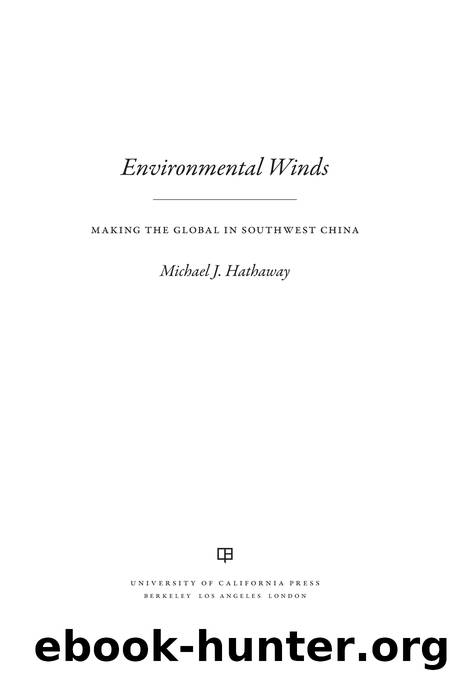Environmental Winds by Hathaway Michael J

Author:Hathaway, Michael J.
Language: eng
Format: epub
ISBN: 9780520276192
Publisher: University of California Press
Sacred Lands and Feudal Superstition: The Uneven Work of Displacement
Although Pei’s work on sacred lands provided new ways of understanding Yunnan’s social landscape, it wasn’t easy to displace deeply embedded perceptions that had become part of the social landscape. In particular, his use of the terms sacred lands and sacred forests had to compete with older notions of superstition (mixin).13 This challenge paralleled attempts by Chinese experts who were trying to find terms to translate the positive connotations of indigenous people, given that the most popular translation of that term, tuzhu ren, was already contaminated, as Old Zhang showed us. Although there is rarely any mention of mixin in the texts that document or celebrate the existence of China’s “sacred forests,” this burden of language and the history of its social affect is in fact one of the biggest obstacles to the spread of these new concepts in China beyond a relatively small group of experts.
This situation became clear to me during my fieldwork in Northwest Yunnan in 2002, when I talked with a nature reserve official. We discussed a forest grove that would later be referred to as a sacred forest in UNESCO documents. I asked this official, Hu Lihua, where I could see examples of older forests, preferably some remnants of the “original” forests. The nearby slopes were full of scrubby pines. Looking at a large plaster model of the surrounding watershed, Hu pointed at one place and said, “Around here, they still have big trees. Big oaks.” I asked why that patch remained and not others. Hu looked down, considered his response, and somewhat sheepishly answered, “Yinwei tamen de fengjian mixin [Because of their feudal superstition].” Fengjian mixin, a Marxist historiographic term, which, like many such terms, came from Japanese Marxists, was a key concept used throughout the Mao era to criticize past beliefs as unscientific and irrational.14 The term was especially consequential during the Cultural Revolution, when it motivated violence against people (such as shamans) and objects (such as temples or statues) seen as emblematic of superstition (Dirlik 1978; Hathaway 2010a). Unlike terms such as “traditional” (chuangtong), which can have a positive valence and suggest something worth saving, mixin is always problematic, describing “outdated beliefs.” It is used, for example, by contemporary Chinese teenagers to criticize their parents’ old-fashioned notions.15
As Hu saw it, the continued presence of these old trees was evidence that feudal superstitions had survived the turmoil of the past. Although he was only a child during the Cultural Revolution, for him, the trees still represented a continuing struggle between superstition and science. These old trees revealed the state’s lack of success, and indeed his own lack of success, in fostering more scientific understandings of the world. In fact he saw his job as teaching peasants about scientific management. In some ways, it was remarkable that this forest patch remained; it shows that locals played an active role in protecting these trees while most of the surrounding lands were deforested. Especially from the 1950s
Download
This site does not store any files on its server. We only index and link to content provided by other sites. Please contact the content providers to delete copyright contents if any and email us, we'll remove relevant links or contents immediately.
International Integration of the Brazilian Economy by Elias C. Grivoyannis(98389)
The Radium Girls by Kate Moore(11967)
Turbulence by E. J. Noyes(7977)
Nudge - Improving Decisions about Health, Wealth, and Happiness by Thaler Sunstein(7654)
The Black Swan by Nassim Nicholas Taleb(7054)
Rich Dad Poor Dad by Robert T. Kiyosaki(6506)
Pioneering Portfolio Management by David F. Swensen(6253)
Man-made Catastrophes and Risk Information Concealment by Dmitry Chernov & Didier Sornette(5951)
Zero to One by Peter Thiel(5729)
Secrecy World by Jake Bernstein(4698)
Millionaire: The Philanderer, Gambler, and Duelist Who Invented Modern Finance by Janet Gleeson(4417)
The Age of Surveillance Capitalism by Shoshana Zuboff(4243)
Skin in the Game by Nassim Nicholas Taleb(4200)
Bullshit Jobs by David Graeber(4136)
The Money Culture by Michael Lewis(4127)
Skin in the Game: Hidden Asymmetries in Daily Life by Nassim Nicholas Taleb(3960)
The Dhandho Investor by Mohnish Pabrai(3721)
The Wisdom of Finance by Mihir Desai(3691)
Blockchain Basics by Daniel Drescher(3535)
